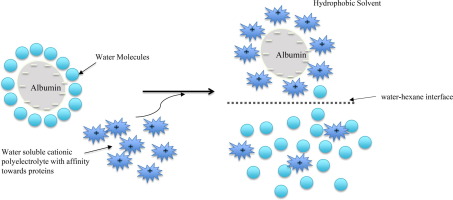Separation and Purification Technology ( IF 8.1 ) Pub Date : 2018-06-02 , DOI: 10.1016/j.seppur.2018.06.003 Varun Gejji , Sandun Fernando

|
Separation of proteins from a complex multi-component suspension of broken down cells is technically challenging. In this regard, a technique that is capable of distinguishing proteins from other major cellular components (such as carbohydrates, lipids, and other cellular debris) could immensely simplify downstream processing. In this work, we report the ability to use the inherent zwitterionic properties of proteins to latch amphiphilic cationic electrolytes on to protein surfaces so that proteins can be extracted from an aqueous suspension into a water-immiscible organic solvent. Here we show the separation of egg albumin (a model protein) from an aqueous suspension to adjacent hexane phase using poly-(diallyl dimethyl ammonium) chloride (PolyDADMAC). Results show that, under optimum pH and polyelectrolyte concentrations, proteins can be successfully migrated from water to the adjacent hexane phase. The amount and molecular weight of electrolyte, and solution pH played vital roles in determining the amount of protein that could be migrated. Low molecular weight polyelectrolyte under neutral pH conditions, low equilibration time and 1:2 hexane: water ratio favored highest protein separation (∼85% dry weight). FTIR studies indicated that the secondary structure of the protein was preserved after migration of the protein from the aqueous phase to solvent under the protection of the polyelectrolyte coating. The results suggest that ionic electrolytes with hydrophobic moieties could be used as molecular transport vehicles to safely separate proteins from a bulk aqueous phase to an immiscible solvent phase.
中文翻译:

基于聚电解质的技术,用于将蛋白质从水相螯合到有机溶剂中
从破碎细胞的复杂多组分悬浮液中分离蛋白质在技术上具有挑战性。在这方面,一种能够将蛋白质与其他主要细胞成分(例如碳水化合物,脂质和其他细胞碎片)区分开的技术可以极大地简化下游加工。在这项工作中,我们报告了利用蛋白质固有的两性离子特性将两亲阳离子电解质锁存到蛋白质表面的能力,这样可以将蛋白质从水性悬浮液中提取到与水不混溶的有机溶剂中。在这里,我们显示了使用聚(二烯丙基二甲基铵)氯化物(PolyDADMAC)从水性悬浮液到相邻的己烷相中分离蛋清蛋白(一种模型蛋白)。结果表明,在最佳pH和聚电解质浓度下,蛋白质可以成功地从水中迁移到相邻的己烷相中。电解质的量和分子量以及溶液的pH在确定可以迁移的蛋白质量方面起着至关重要的作用。在中性pH条件下,低平衡时间和1:2的己烷:水比例下的低分子量聚电解质有利于最大的蛋白质分离(〜85%干重)。FTIR研究表明,在聚电解质涂层的保护下,蛋白质从水相迁移到溶剂后,蛋白质的二级结构得以保留。结果表明,具有疏水性部分的离子电解质可用作分子转运载体,以安全地将蛋白质从大量水相分离到不混溶的溶剂相。电解质的量和分子量以及溶液的pH在确定可以迁移的蛋白质量方面起着至关重要的作用。在中性pH条件下,低平衡时间和1:2的己烷:水比例下的低分子量聚电解质有利于最大的蛋白质分离(〜85%干重)。FTIR研究表明,在聚电解质涂层的保护下,蛋白质从水相迁移到溶剂后,蛋白质的二级结构得以保留。结果表明,具有疏水性部分的离子电解质可用作分子转运载体,以安全地将蛋白质从大量水相分离到不混溶的溶剂相。电解质的量和分子量以及溶液的pH在确定可以迁移的蛋白质量方面起着至关重要的作用。在中性pH条件下,低平衡时间和1:2的己烷:水比例下的低分子量聚电解质有利于最大的蛋白质分离(〜85%干重)。FTIR研究表明,在聚电解质涂层的保护下,蛋白质从水相迁移到溶剂后,蛋白质的二级结构得以保留。结果表明,具有疏水性部分的离子电解质可用作分子转运载体,以安全地将蛋白质从大量水相分离到不混溶的溶剂相。在中性pH条件下,低平衡时间和1:2的己烷:水比例下的低分子量聚电解质有利于最大的蛋白质分离(〜85%干重)。FTIR研究表明,在聚电解质涂层的保护下,蛋白质从水相迁移到溶剂后,蛋白质的二级结构得以保留。结果表明,具有疏水性部分的离子电解质可用作分子转运载体,以安全地将蛋白质从大量水相分离到不混溶的溶剂相。在中性pH条件下,低平衡时间和1:2的己烷:水比例下的低分子量聚电解质有利于最大的蛋白质分离(〜85%干重)。FTIR研究表明,在聚电解质涂层的保护下,蛋白质从水相迁移到溶剂后,蛋白质的二级结构得以保留。结果表明,具有疏水性部分的离子电解质可用作分子转运载体,以安全地将蛋白质从大量水相分离到不混溶的溶剂相。FTIR研究表明,在聚电解质涂层的保护下,蛋白质从水相迁移到溶剂后,蛋白质的二级结构得以保留。结果表明,具有疏水性部分的离子电解质可用作分子转运载体,以安全地将蛋白质从本体水相分离到不混溶的溶剂相。FTIR研究表明,在聚电解质涂层的保护下,蛋白质从水相迁移到溶剂后,蛋白质的二级结构得以保留。结果表明,具有疏水性部分的离子电解质可用作分子转运载体,以安全地将蛋白质从大量水相分离到不混溶的溶剂相。











































 京公网安备 11010802027423号
京公网安备 11010802027423号